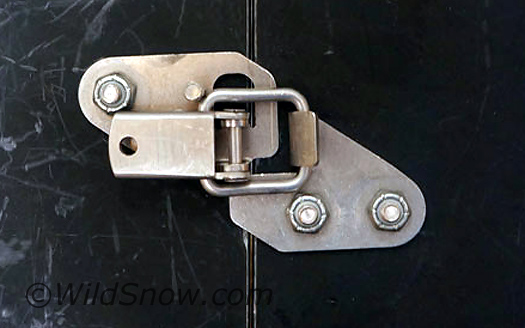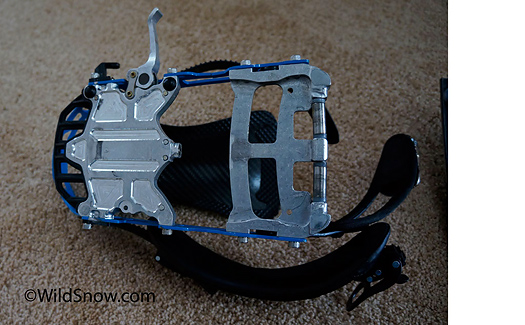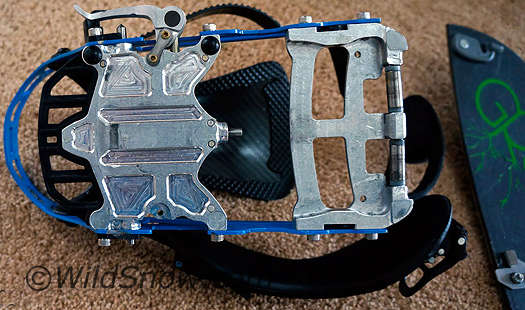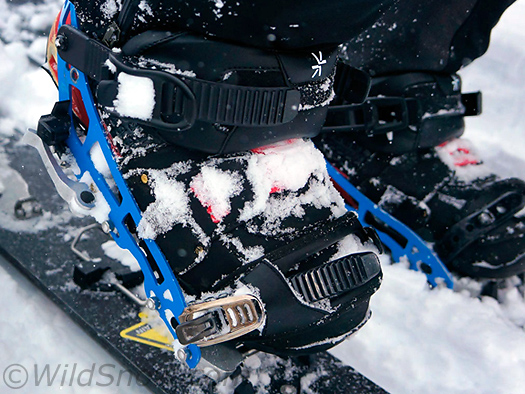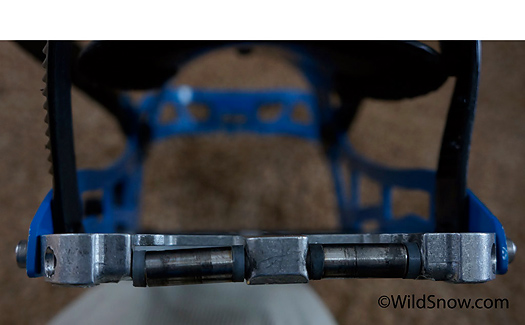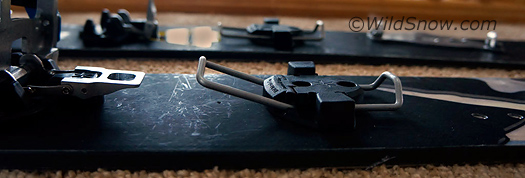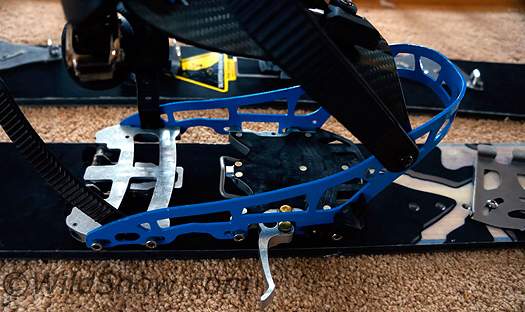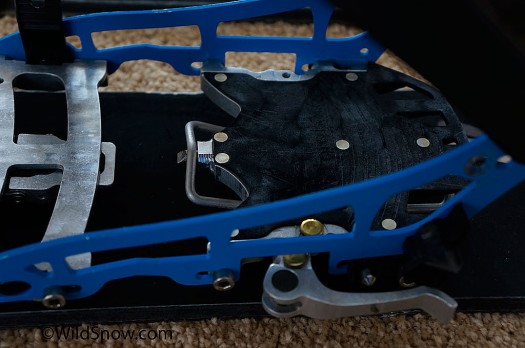Jonathan Cooper
It doesn’t take much to notice the current rise in the popularity of splitboarding. Development and innovation are at all-time high. In 2008, Karakoram came out with their completely new interface system. It approached the problems of splitboard performance from a new direction, and managed to create a binding that was lighter, more technical, and much different than anything else on the market. The product in review is one of three bindings that Karakoram currently has on the market. The Carbon Super Light series is their middle of the line binding that has many weight-saving features, as compared to their original Split30 binding.
The obvious difference with this system, as compared to most other splitboard binding interfaces, is the puck-less system that attaches the accompanying binding to the board. This two piece interface has five attachment points that work to actively pull the board together and bring the binding closer to the board when in ride mode.

The interface is made of aluminum and features an easy-to-use angle adjustment for quick field modifications.
In addition to this, the Karakoram board clips provide an active attachment mechanism that further creates a more solid performance out of the board (as opposed to the traditional hooks that passively connect the board found on most factory made splitboards). I have been riding this system for two years, and the board clips alone have made my board perform much better, and much less like a splitboard.
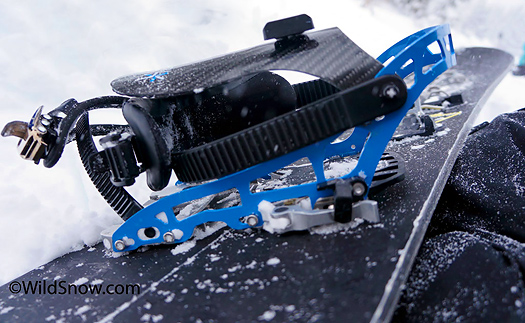
The bindings themselves are an innovative blend of a traditional snowboard binding and weight-saving engineering.
The two attachment components (heel stay and toe stay) on the binding are made of aluminum. The heel stay houses a quick-release lever that engages/disengages three separate titanium pins that attach the binding to the interface. I have found this feature to be extremely effective in clearing snow from the attachment points without much preventative effort on my part (especially in deep snow and gloppy spring conditions). The lever itself has a cam-over action that feels secure when attaching the binding in ride-mode. Just in case, Karakoram has recently added a plastic safety component that prevents the quick-release lever from opening up.
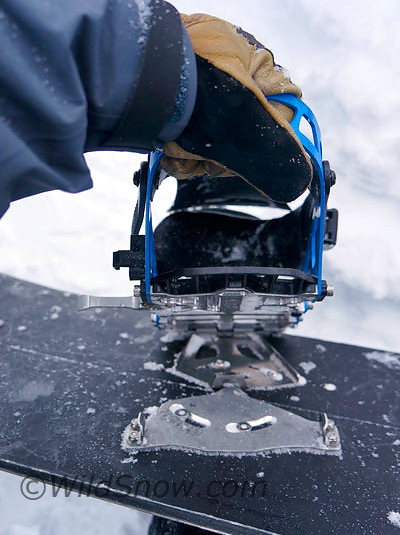
The machined-out heel cup, specific to the Carbon SL, shaves some weight compared to the older Split 30. The heel cup, accompanied by the removal of excess material in the heel stay, and the carbon fiber high-back bring each binding to a weight of around 700 grams.

The tour mode interface features a bracket made of Dupont Zytel engineered plastic and a stainless steel clamp.
The toe-stay on the binding has a touring axle with two stainless steel sleeves that rotate around the axle when it is clamped in the touring bracket. The axle itself is threaded on one end and screws into one side of the toe stay. The opposite side has a small pin that is hammered in to prevent the axle from backing out. The binding then pivots around this axle in tour mode.
A major benefit I have seen from this interface is the ability to transition from ride mode into tour mode without taking your feet out of your bindings. Simply open the quick release lever and step into tour mode (after splitting and skinning your board of course). This feature continues to shave time off of my transitions, which is especially beneficial when touring with skiers on a multiple lap outing. Anything to dispel the notion of slowboarder is a winning feature in the splitboarding world.
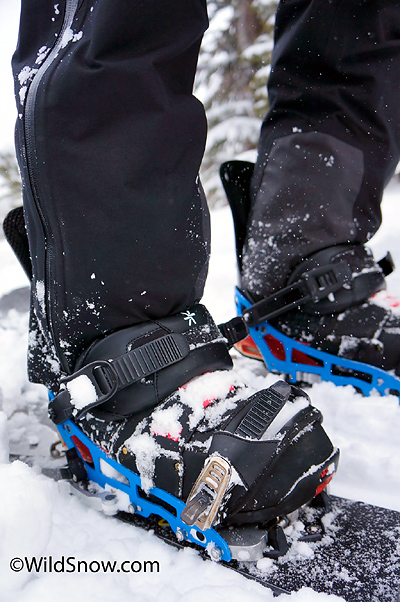
With the touring clamp opened it is simple to step in and down to close the clamp, securing the binding into the bracket.
Despite the ease of the integrated axle, it has suffers from a few problems which have directly affected the strength and integrity of my touring axle. As I mentioned above, one side of the axle is threaded and screws into the corresponding side of the toe-stay. This threading of the axle has created a point of weakness, especially in tour mode. Over the last two seasons of moderate use (50+ days), I have managed to completely shear the axle in half. This point of breakage happened right where the threaded axle enters the toe-stay housing. At this intersection the touring axle sees the most force, and in combination with the threading, serious fatigue has occurred causing the axle to fail.
This seems to be a fairly isolated issue. Apparently there has only been one other reported case of this happening to the touring axle. This could be due to slight variations in the manufacturing process, or just a matter of time for other users. Regardless, a design alteration would seem essential to minimize the force and fatigue at this intersection of the touring axle and the toe-stay housing.
In lieu of the axle failure, I was out on Berthoud Pass in Colorado touring and taking mellow tree runs this past weekend and did not notice significant play while riding, although anything more than mellow powder runs would probably be more concerning. The folks at Karakoram have been very helpful through this process and have sent me new toe-stays in the mean time.
Another key feature, and unique to Karakoram at this time, is the heel-lock down mechanism. This has been on the wish list for splitboarders for a long time. This feature is integrated into their dual climbing bar component (I appreciate multi-functional components). The taller climbing bar can be pulled out into a 3rd position to accommodate the center titanium pin in the heel-stay.
It is easy to engage on the fly while in tour mode, as you open the quick-release lever, adjust the climbing bar, and re-engage the lever to lock the binding down. According to Karakoram, the heel lock-down feature is not meant for downhill skiing (most likely because it is not releasable). I tested it skiing down a mellow access road, sidestepping, and sidehilling. In my opinion, this feature greatly increases safety and the ability to move through sketchy side hills, and short down-hill sections on long tours. Although I have not fully tested the strength of the climbing bar as a mechanism to lock the heel down, I do see limitations. There is potential for high levels of force being loaded on the climbing bar while the heel is locked down. I would like to see a component that is fully rated to split-ski (as much as is realistic for a splitboard and snowboard boots) without the worry of failure. Regardless, there is a solution to the problem of locking the heel down which has not previously existed.
A last noteworthy component of the Karakoram binding interface is the ski crampon attachment. Over the years I have come to realize that ski crampons for splitboards are a must when the conditions become even slightly less than ideal (i.e. hard, icy traverses). This is largely due to the lack of lateral stiffness while touring, which is mostly a result of soft snowboard boots. The Karakoram ski crampons attach directly to the binding, and can be mounted while in tour mode with relative ease. With the quick release lever open, the crampon slides under the binding and hooks two bolts that screw the heel cup into the toe stay. The quick-release lever engages and locks the crampon into the binding. These crampons (and the binding as a whole) performed well on a recent trip to Mt. Rainier in January. (see Wildsnow TR here).
Overall, the Karakoram Carbon SL splitboard bindings seem to have succeeded in pushing the technical development of the sport and the gear. Although one of the priciest products on the market, the small Washington based company seems to be committed to continual development and refining of their product, as new improvements seem to come out every few months. Check them out and see their line-up at www.karakorambc.com.
(Guest blogger, Jonathan Cooper, is a recent Western Washington University graduate balancing work with traveling around the world. He currently lives and skis in Colorado, and often drops in on the Cascade mountains to explore snowy peaks with friends.

Jonathan Cooper (“Coop”) grew up in the Pacific Northwest and has been playing in the mountains since he was a teen. This was about the same time he made the fateful decision to strap a snowboard to his feet, which has led to a lifelong pursuit of powdery turns. Professionally speaking, he has been working as a ski guide, avalanche educator, and in emergency medicine for over a decade. During the winter months he can be found chasing snow, and passing on his passion for education and the backcountry through teaching avalanche courses for numerous providers in southwest Colorado, and the Pacific Northwest. Similarly, his passion for wilderness medicine has led him to teach for Desert Mountain Medicine all over the West. If you’re interested, you can find a course through Mountain Trip and Mountain West Rescue. In the end, all of this experience has merely been training for his contributions to the almighty WildSnow.com.



